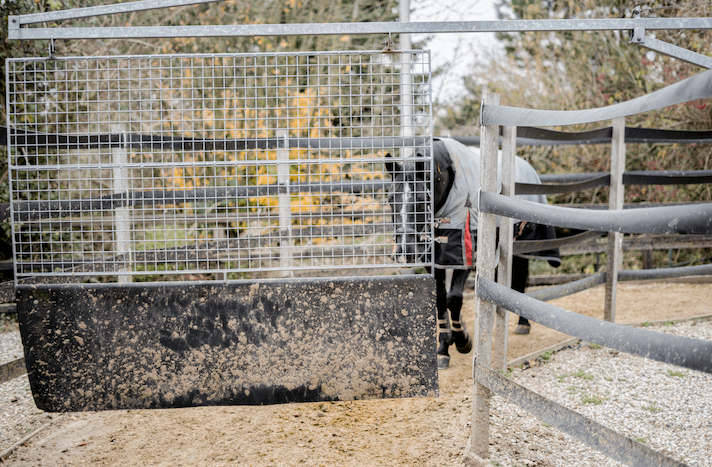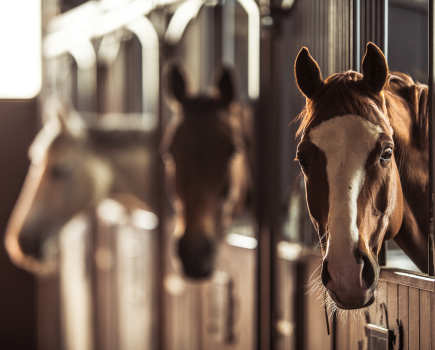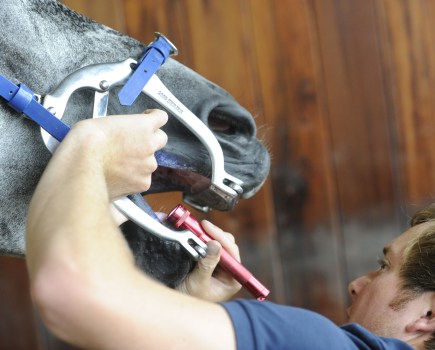A horse walker is the perfect place for controlled exercise — and they really come into their own in winter, when we strive to get our charges out of their stable and moving as much as possible for the good of their physical and mental health.
A lot of livery yards, and many professional yards, have a horse walker, and for many people putting their horse on the walker is part of their daily routine. Yet rumours abound about how long it is safe for equines to be on a walker for, are they really a necessity or just a luxury, and can walking around in endless circles lead to injury?
The benefits
According to Mary Frances BHSII BHS SM, chief executive of Moorcroft Equine Rehabilitation, there are benefits to using a walker if care is taken and careful thought is given to each horse’s specific needs.
These include:
- The rider being sidelined — perhaps due to illness, injury or being on holiday. If the horse is not going to be ridden for some time, a walker is a good way to keep them moving.
- Alleviating/preventing stiffness — “Stiff horses can improve as they walk off the stiffness [while on the walker] and use their bodies in a good way without a rider,” explains Mary.
- Reducing filled legs, which some horses are particularly prone to after standing in a stable overnight. On a walker, they can walk this off before they are ridden. “During a day off from ridden exercise or turnout, a walker can also help to ensure that those legs don’t fill up,” adds Mary.
- Getting used to enclosed spaces — “Shy loaders [into a horsebox] can improve following daily use of a walker for short periods of time as they get used to being loaded into a confined space and realise that they are safe, leading to confidence when being transported, too,” says Mary.
After box rest or time off
If a horse misses out on being ridden for a long length of time, such as due to injury, a walker is a good place to start when bringing them back into work.
“A walker can be a safe place to start controlled exercise for a horse coming off box rest if the circling doesn’t put too much strain on previously injured limbs or other parts of their anatomy,” agrees Mary.
“In fact, using a walker can be a safer environment than trying to walk a horse in-hand if they are full of beans and difficult to control. Take great care to ensure that they walk calmly on the walker, though.”
I can vouch for using a horse walker for this reason. There have been times when I’ve had to mount a fresh ex-racehorse after some time off and sit very tight, wishing they had had access to a walker to take the edge of first.
Lunging, of course, is an alternative option in this scenario, but not when they are returning from injury for fear of them becoming too excited and causing even more damage to their body.
Introducing a horse walker
If it is a horse’s first time being on the walker, it is important that they have a good experience. Mary recommends putting them on behind another more experienced horse, so that it is a less isolating experience.
“I walk into the cage with any new horse, giving them a carrot and ensuring that all is well and assuring them that they have no reason to feel nervous,” explains Mary.
“Most horses cope well. Seeing another well-established and calm horse in the cage in front will create a herd environment and make things less alien, too.”
This arrangement tends to prevent a horse trying to turn around within the cage, too, which is a bad habit that shouldn’t be allowed to happen.
“Most horses want to follow the tail in front of them and this should instil good habits naturally,” confirms Mary.
Quick leg stretch
Once a horse has become used to the walker, it can be useful to put them on for 10 minutes while you muck out their stable. This gives you more space to work, gives the horse a leg stretch, and avoids them breathing in any dust you create while mucking out and putting down a fresh bed.
“[A leg stretch] is useful for older equines who may suffer from joint stiffness or filled legs after a night in,” adds Mary.
It is also common practice for people to put their horse on a walker before and after riding to aid with warming up and cooling down.
My sister once rode an ex-racehorse prone to tying up (azoturia) and a real stress-head if stabled for long periods. So at Pony Club Camp one year, he was given special permission to go on the horse walker at Duchy College each morning, evening, and before and after work, so that he could move. Doing this kept him happy and healthy for five days of camp, during which turnout was limited.
Best practice
As a horse is walking in a continuous circle while on a walker, care must be taken when it comes to any injuries or ailments they may be suffering from, or have had in the past.
Remember:
- Short sessions are best — “Never leave your horse on the walker for long periods; never for longer than 15 minutes on each rein. Short sessions are better and more valuable,” confirms Mary.
- Change the rein regularly and spend equal time on both reins. If this isn’t possible within a session, make sure your horse goes round the opposite way next time they’re on the walker.
- Reward your horse before and after a session, so that they associate being on the walker as a rewarding experience.
- Listen to your horse — if the weather is poor and wind and rain are creating noise and they’re becoming unsettled, take them off the walker.
- Give them a friend — horses are herd animals, after all, so being on a walker with company will be a happier experience for them.
Tack or no tack?
Your horse can wear tack, says Mary, if you’re using a covered walker to warm them up before schooling or hacking. It’s a useful think to do, especially in winter.
“Leave tack off, though, if the walker isn’t covered so that it doesn’t receive a soaking in the event of rain,” she advises.
“If they are tacked up for the session, ensure that the reins are tied up in the throat lash and that no elements of the saddle can get caught up in the walker.”
After care
“Monitoring your horse after each session on the walker will tell you if it is having an adverse effect and, if so, you will need to act accordingly and give them time away,” instructs Mary.
“I find that if horses aren’t happy using the walker and they start to feel fatigue in their joints, for example, they will soon tell you by hesitating when you try to put them on, or by showing stiffness afterwards.
“Therefore, make sure that you take note of and act upon any changes your horse may show — good and bad.”
Insurance
Although accidents involving a horse walker are rare, they do occur, and so it is important to check whether these are covered in your yard’s insurance policy, as well as any policy you have for your horse (vet fees for example).
“Accidents usually occur with horses who aren’t familiar with the operating environment of the walker, so ensure your horse’s first experience is a happy and accident-free one,” adds Mary.
“Be aware that the walker has a motor, so there will be a certain amount of noise close to the entrance which initially can put some off until they get familiar with it. Again, if handled well, this provides a useful familiarisation to noise for young horses.”
Main image © Shutterstock










